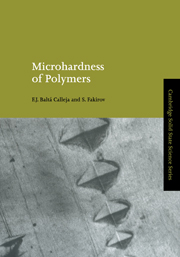Book contents
- Frontmatter
- Contents
- Preface
- Chapter 1 Introduction
- Chapter 2 Microhardness determination in polymeric materials
- Chapter 3 Microhardness of glassy polymers
- Chapter 4 Microhardness of crystalline polymers
- Chapter 5 Microhardness of polymer blends, copolymers and composites
- Chapter 6 Microhardness of polymers under strain
- Chapter 7 Application of microhardness techniques to the characterization of polymer materials
- Author Index
- Subject Index
Chapter 6 - Microhardness of polymers under strain
Published online by Cambridge University Press: 23 October 2009
- Frontmatter
- Contents
- Preface
- Chapter 1 Introduction
- Chapter 2 Microhardness determination in polymeric materials
- Chapter 3 Microhardness of glassy polymers
- Chapter 4 Microhardness of crystalline polymers
- Chapter 5 Microhardness of polymer blends, copolymers and composites
- Chapter 6 Microhardness of polymers under strain
- Chapter 7 Application of microhardness techniques to the characterization of polymer materials
- Author Index
- Subject Index
Summary
Polymorphic transitions in crystalline polymers
When polymers crystallize from the melt or solution, the crystalline regions may exhibit various types of polymorphic modification, depending on the cooling rate, evaporation rate of solvent, temperature and other conditions. These crystal modifications differ in their molecular and crystal structures as well as in their physical properties. Many types of crystalline modifications have been reported (Tashiro & Tadokoro, 1987). (See also Chapter 4.)
Some polymorphic modifications can be converted from one to another by a change in temperature. Phase transitions can be also induced by an external stress field. Phase transitions under tensile stress can be observed in natural rubber when it orients and crystallizes under tension and reverts to its original amorphous state by relaxation (Mandelkern, 1964). Stress-induced transitions are also observed in some crystalline polymers, e.g. PBT (Jakeways et al., 1975; Yokouchi et al., 1976) and its block copolymers with poly (tetramethylene oxide) (PTMO) (Tashiro et al., 1986), PEO (Takahashi et al., 1973; Tashiro & Tadokoro, 1978), polyoxacyclobutane (Takahashi et al., 1980), PA6 (Miyasaka & Ishikawa, 1968), PVF2 (Lando et al., 1966; Hasegawa et al., 1972), polypivalolactone (Prud'homme & Marchessault, 1974), keratin (Astbury & Woods, 1933; Hearle et al., 1971), and others. These stress-induced phase transitions are either reversible, i.e. the crystal structure reverts to the original structure on relaxation, or irreversible, i.e. the newly formed structure does not revert after relaxation. Examples of the former include PBT, PEO and keratin.
- Type
- Chapter
- Information
- Microhardness of Polymers , pp. 176 - 204Publisher: Cambridge University PressPrint publication year: 2000



